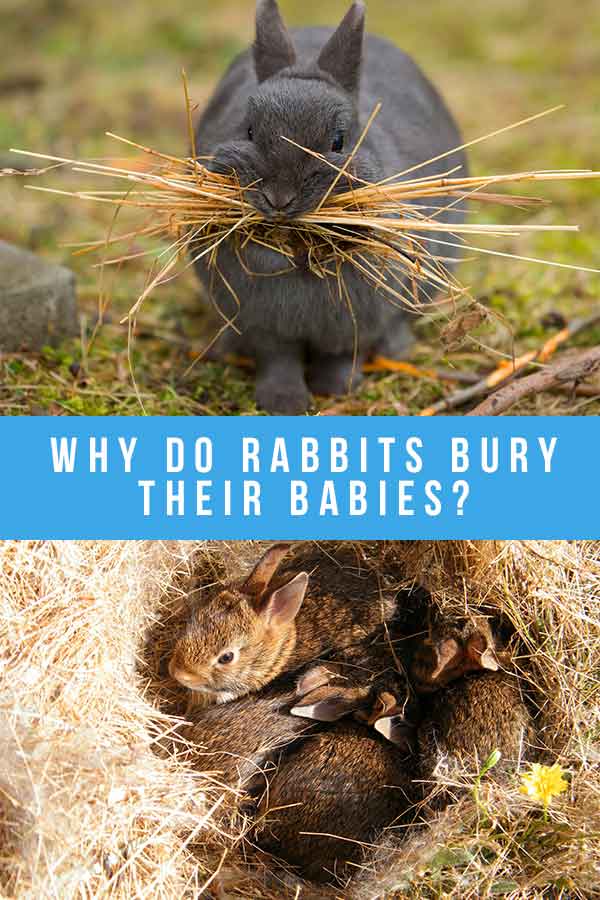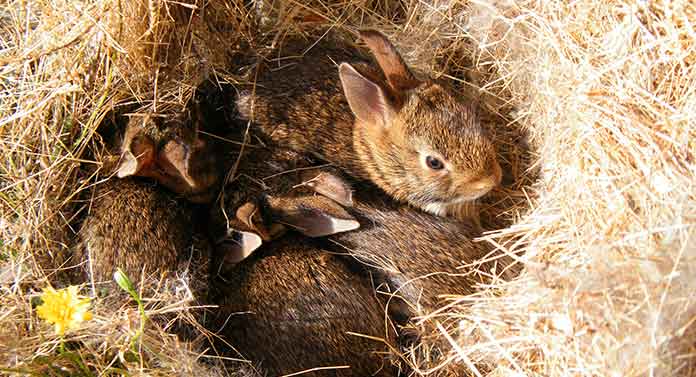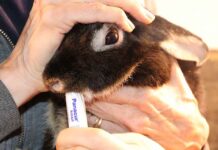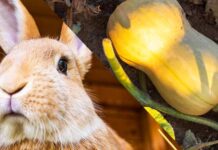Why do rabbits bury their babies under piles of grass and leaves?
Female rabbits (does) hide their babies (kittens) in shallow nests, under a covering of grass and vegetation.
It keeps them warm, safe from predators, and all in one place, until she can come back to feed them again.
If you find a litter of buried kittens, it’s best to leave them untouched for their mom to come back to.
Why Do Rabbits Bury Their Babies?
Female rabbits hide their babies under a light covering of grass and other vegetation as a means of protecting them.
Which may come as a surprise if she’s done it in the middle of your neatly mown lawn!
Is there really method in her madness? Can her litter be safe there?
And if you don’t see her again for hours or days, does it mean she’s buried her litter and abandoned them?
At what point should you intervene to help them?
We’re going to take a look at why rabbits bury their babies, how it to helps them to survive, and what you should do if you find a litter of babies buried in your yard.
Let’s start at the beginning.

Baby Rabbit Facts
The most common rabbit species in North America is the Eastern Cottontail, which lives in large numbers all over the eastern and central regions of the United States.
But several very similar species can also be found, including:
- Nuttall’s cottontails and desert cottontails (in the south west, north west, and north central states).
- Appalachian cottontails (restricted, unsurprisingly, to the Appalachian Mountains).
- swamp rabbits (widespread across the south east and south central regions).
- and marsh rabbits (mostly restricted to Florida).
All these rabbit species usually breed and raise litters in late spring, summer, and early autumn.
But in some places with a mild climate (like Texas) they’ve been observed rearing babies all year round.
The number of kittens, or kits, in a litter depends upon factors including:
- species
- time of year
- and how old their mom is.
But 3 – 5 kittens per litter is about average.
Where Do Rabbits Have Their Babies?
Wild rabbits nest in pastures, woodland, and even mowed lawns.
They are fond of open spaces, which often takes people by surprise, because we tend to think it makes them more vulnerable.
But actually there’s a clever logic to it, because most predators of rabbits avoid open spaces themselves.
Some observers also think that rabbits might be particularly drawn to lawns and backyards because the smell of people and pets living there will deter predators even more.
Nest Building
Eastern Cottontails and the closely related bunny species listed above make their nest by digging a shallow basin, about 5 – 7 inches long, 4 or 5 inches wide, and 3.5 – 5 inches deep.
These are also known as pocket nests.
To make it warm and cozy, the pregnant doe plucks fur from all over her own body, and uses it to line the nest.
She’ll also bring in grass and straw from outside the nest to insulate it and make it comfy.
And finally she’ll add a layer of grass, straw, leaves, and stems from herbaceous plants with which to conceal her babies.
She might also rely on vegetation which is already overhanging the nest.
Nests in unusual places
Whilst most wild rabbits rely on pocket nests, some have been very creative in looking for alternatives.
One inventive bunny mom was even observed nesting 8 feet off the ground in a wisteria tree!
Completing The Nest And Giving Birth
Rabbits tend to finish their nest just in the nick of time before giving birth.
They typically give birth at night, and their babies are born blind, deaf, and hairless.
The nest will be their home for the next three to four weeks, and during that time their mom will return once a day – usually at dawn or dusk – to feed them.
Rabbit’s milk is so rich in calories and nutrients that just one feed a day will give her kits all the energy they need to grow!
Do Rabbits Bury Their Babies?
In between feeds, mother rabbits kick grass, leaves and vegetation over their kittens to bury them, and leave to graze.
There are several survival advantages to this:
- In cool or windy weather, the extra layer of insulation keeps them warm.
- On hot, sunny days, it protects them from the heat of the sun.
- As the babies get bigger and more mobile, it keeps them all in one place until mom returns.
- And it hides them from predators – both visually, and by masking the smell of the nest.
Help, I’ve Uncovered A Rabbit Nest!
Since so many wild rabbits nest in backyards, you might be lucky enough one day to discover that you’re playing host to your own nest of wild bunnies.
Here are some simple steps to take if you do:
One: If you haven’t already disturbed the nest, leave it alone.
Two: If you have uncovered the nest by accident, for example by raking or mowing, check whether any of the occupants have been injured.
Three: If there are signs of injury, contact your local wildlife service department for advice.
Four: If there aren’t any signs of injury, carefully kick the surrounding leaves and grass back over them (avoid handling it, if you can).
Five: Consider marking the spot where the nest is, so that you remember, and other people in your household know not to disturb it.
Six: Leave it well alone. Remember that mom, will only come back for a few minutes once a day to nurse, and probably at dawn or dusk, so don’t worry if you don’t see any sign of her.
Seven: If you’re worried that the doe has abandoned the nest, place something distinctive on top of it, like a piece of ribbon or a Y-shaped twig, and take a photo of exactly how it looks. In the morning, if it’s been disturbed you’ll know that mom has returned to nurse overnight. If you still suspect she’s abandoned the nest, call wildlife services for advice.
Rabbits are capable of getting pregnant again almost immediately after giving birth, and are frequently pregnant with their next litter whilst nursing one in the nest (hence the phrase “breeding like rabbits”!)
So if you leave a pocket nest in place, you may find that the doe reuses it up to four more times before the end of the season!
Why Do Rabbits Bury Their Babies – Summary
Wild rabbits bury their babies in shallow nests to protect them while they’re too young to fend for themselves.
If you’re lucky enough to find baby rabbits buried in your yard, leave them alone and let their mom rear them undisturbed.
References & Further Reading
Agger. Tularemia, Lawn Mowers, and Rabbits’ Nests. Journal of Clinical Microbiology. 2005.
Feldhamer et al. Wild Mammals of North America: Biology, Management, and Conservation. JHU Press. 2003.
McCallum et al. Arboreal Nesting by an Eastern Cottontail in a Suburban Setting. Northeastern Naturalist. 2008.














